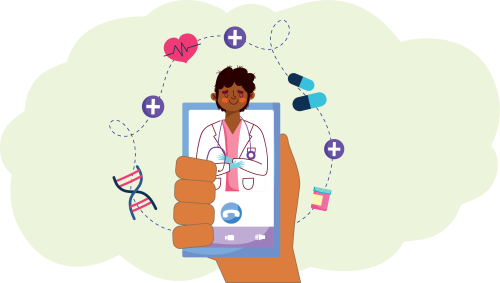Telebehavioral Health: Advancing Access, Equity, and Efficacy in Behavioral Health Care
The rapid virtualization of healthcare services during the Public Health Emergency (PHE) in 2020 may support the widespread adoption of telehealth for behavioral health services, as the research base for assessing and treating mental health conditions demonstrating its effectiveness is over 60 years old. While numerous terms for delivering healthcare services virtually exist and are often used interchangeably (e.g., telemedicine, telehealth, telemental health, telepsychology), a leading researcher and physician, Dr. Donald Hilty, recommends using the term telebehavioral health when referring to the delivery of behavioral health services, as it includes substance use disorders (SUDs).
Numerous meta-analyses have shown the benefits associated with the use of telebehavioral health services. Specifically, telebehavioral health has increased patient access, medication adherence, communication, and outcomes, while showing decreases in missed appointments, wait times, readmissions, and patient travel time (Kruse-Scott, 2017). In essence, telebehavioral health is considered equivalent to in-person care, according to several seminal articles that reviewed the quality and quantity of the research conducted (Batastini et al., 2020; Hilty et al., 2013). While the evidence for providing mental health services virtually is more robust than for SUD treatment services, the number and quality of studies examining the use of telebehavioral health in treating individuals with opioid use disorders and alcohol use disorders has recently expanded and demonstrated positive outcomes. When making the case for telebehavioral health, this statement provides the best summary: the use of synchronous (live) audio and video to deliver behavioral health services is considered “effective, well received by patients, and, for many practitioners, a standard way to deliver services” (Hilty et al., 2017, p.171).

Patients report being helped by telebehavioral health services and express satisfaction with service delivery. Numerous studies show that it is not contraindicated for patients with mental health concerns or SUDs. According to Chakrabarti (2015), all patient populations—children, adolescents, seniors, minority populations, and justice-involved individuals—report satisfaction with telebehavioral health. For some patients, telebehavioral health provides feelings of safety and control (especially those with trauma- or anxiety-related diagnoses), while for others, the sense of “emotional or virtual distance” experienced can at times be off-putting (Shore, 2020). A recent study found that patients participating in an online group reported feeling less connected than group members in in-person sessions. However, additional data confirmed that most of these online group members believed: 1) the convenience of attending group online offset any barriers or difficulties experienced; 2) they probably wouldn’t have been able to attend group sessions if they were not held online; and 3) while an online group was not their first choice, it was preferred over no treatment (Lopez et al., 2020).

According to the American Telemedicine Association (ATA) and American Psychiatric Association (APA) Best Practices Guidelines (Shore, 2018), before providing telebehavioral health services, clinicians should consider a patient’s cognitive capacity; history of cooperativeness with treatment professionals; history of violence or self-injurious behavior, along with access to emergency medical services; support system and its efficacy; and current medical status. Finally, Shore (2020) considered it essential that clinicians regularly assess patients’ comfort level with telebehavioral health in relation to clinical issues and changes in condition or living arrangements.
Some clinicians appear more reluctant to use telebehavioral health, citing concerns about technology negatively impacting the development of therapeutic rapport (Hubley et al., 2016; Kruse-Scott, 2017; Connolly et al., 2018). A recent study with rural providers found similar results and also identified other concerns, including using new software programs, confidentiality issues, and questions about telebehavioral health efficacy (McClellan et al., 2020). Telebehavioral health changes how a clinician provides services, with most of the burden falling on the clinician rather than the patient. For instance, clinicians will need to get training on clinical issues and interventions, learn how to use new technologies, and integrate those technologies and procedures into their existing workflow, whereas patients will only need to learn how to use the technology (Connolly et al., 2018).

Numerous research findings, guidelines and tips, and training/technical assistance (TA) activities are now available to help clinicians adopt telebehavioral health services and increase proficiency. First, Batastini and colleagues (2020a) found that rapport could be built while providing mental health services in justice settings. Specifically, clinicians were able to virtually “project openness, interest, and inquisitiveness by expressing exaggerated postures and thoughtful inflection when speaking; introduce humor; and offer therapeutic challenges with a Motivational Interviewing style.” Next, the ATA and APA created new guidelines (Shore, 2018) for delivering telebehavioral services focused on legal and regulatory issues, standard operating procedures, and technical/clinical considerations. In addition, the Center for Excellence on Privacy and Security developed tip sheets for clinicians that highlight HIPAA privacy and security issues and Federal Confidentiality 42 CFR Part 2 regarding virtual service delivery. Finally, the APA published guidelines for running group counseling sessions online with helpful suggestions.
Most importantly, a recent study by McClellan and colleagues (2020) found that “clinicians with more telehealth knowledge and experience tend to also have more favorable opinions of telehealth and vice versa” (p. 71). The implications of this study are significant: increasing knowledge about the effectiveness of telebehavioral health and promoting skill proficiency through training and TA can increase clinicians’ positive attitudes toward telebehavioral health, leading to more widespread adoption. Most clinicians will require specific training and TA on telebehavioral health, as most academic programs do not offer courses or modules on virtual service delivery—although all professional associations (e.g., ACA, NASW, AAMFT, APA) have technology practice standards for their members. As such, organizations should consider the need for training and TA when planning the implementation of telebehavioral health.

Numerous videoconferencing platforms are available (e.g., Zoom, Microsoft Teams, GoTo Meeting, Skype for Business, Cisco WebEx, ezTalks Meeting, Starleaf). Other platforms specifically used by behavioral health clinicians include Doxy.me, Clocktree, and VSee. Zoom has become the premier platform, largely due to its video-first engineering (i.e., the service is built from the ground up for video, engineered to be cloud-native, and optimized for video). Experts agree that the videoconferencing platform should have end-to-end encryption, meaning communication is protected while it is transferred from one end system or device to another (TechTarget Network). In addition, providers should ensure that the videoconferencing vendor signs a Business Associate Agreement (BAA) with their organization. A helpful reminder: equipment is not HIPAA-compliant; rather, it is the provider’s responsibility to conduct assessments and ensure HIPAA compliance for services delivered via telebehavioral health, including documentation of actions taken to protect patient privacy and security.
In May 2021, Becker’s Hospital Review identified sixteen key takeaways from six telehealth reports. Although these reports focused on healthcare services in general rather than behavioral health services, the data confirmed the following: nearly two-thirds of healthcare providers are shifting services to include virtual delivery; 42% of patients prefer a hybrid model (in-person and telehealth); small physician offices reported more negative perceptions about shifting to virtual care; and 85% of patients surveyed said telehealth made it easier to access services. These findings have important implications for behavioral health practitioners, particularly in terms of patient satisfaction and expectations for virtual or hybrid service delivery—and how healthcare providers are adapting accordingly.

A survey conducted with behavioral health providers (Molfenter et al., 2021) asked clinicians about their use of telehealth to deliver clinical services. When comparing video to telephone service delivery, clinicians perceived video services as more appealing but telephone services as more accessible—suggesting that both channels play important roles. These findings highlight ongoing policy and reimbursement issues. During the PHE, all 50 states and Washington, D.C. issued guidance allowing for audio-only telehealth services. Many policymakers and legislators are now advocating for audio-only or telephonic telehealth services to remain reimbursable post-PHE. The Center for Connected Health Policy identified several legislative trends, including: federal bills aimed at making temporary changes permanent; state-level payment parity for private payers; Medicaid audio-only services (just for behavioral health); licensing for out-of-state providers; and state regulatory boards creating telehealth regulations.
In June 2021, the Substance Abuse and Mental Health Services Administration (SAMHSA) released a new guide in its Evidence-Based Resource Guide Series. This guide focuses on using telehealth (videoconferencing) to deliver treatment and recovery support services for individuals with serious mental illness (SMI) and SUDs. Telehealth remains a priority for SAMHSA, as it increases access to treatment and recovery services.
Finally, Shore (2020) recommended that the lessons learned during the rapid virtualization of behavioral health services due to the PHE could be used to create a hybrid model that benefits patients. In this model, services would include a combination of in-person sessions, online sessions, telephone check-ins or consultations, and the use of apps and/or wearables that report data directly to the clinician. Maintaining current virtual service delivery and/or implementing telebehavioral health services is crucial to increasing access to treatment and recovery support services and improving overall service delivery. As such, clinicians will need assistance in honing their telebehavioral health skills—support that is available through CASAT.
The future is here, with telebehavioral health serving as a vector for greater patient satisfaction and utilization of behavioral health services.
References
Backhaus, A., Agha, Z., Maglione, M.L., Repp, A., Ross, B., Zuest, D., . . .Thorp, S.R. (2012). Videoconferencing psychotherapy: A systematic review. Psychological Services, 9, 111–131. http://dx.doi.org/10.1037/a0027924
Batastini, A.B., Jones, A.C.T., Lester, M.E., Davis, R.M. (2020). Initiation of a multidisciplinary telemental health clinic for rural justice‐involved populations: Rationale, recommendations, and lessons learned. Journal of Community Psychology, 48(7), 2154– 2173. https://doi.org/10.1002/jcop.22424
Batastini, A.B., Paprzycki, P., Jones, A.C.T., & MacLean, N. (under review). Are videoconferenced mental and behavioral health services just as good as in‐person? A meta‐analysis of a fast‐growing practice.
Bastini, A.B., King, C.M., Morgan, R.D., et al. (2016). Telepsychological services with criminal justice and substance abuse clients: A systematic review and meta-analysis. Psychological Services, 13(1),20–30.
Bosworth, A., Ruhter, J., Samson, L.W., Sheingold, S., Taplin, C., Tarazi, W., & Zuckerman,R. (2020). Medicare beneficiary use of telehealth visits: Early data from the start of COVID-19 pandemic. Washington, DC: Office of the Assistant Secretary for Planning and Evaluation, U.S. Department of Health and Human Services.
Chakrabarti, S. (2015). Usefulness of telepsychiatry: A critical evaluation of videoconferencing-based approaches. World Journal of Psychiatry, 5(3), 286-304
Connolly, S.L., Miller, C.J., Lindsay, J.A., & Bauer, M.S. (2020). A systematic review of providers’ attitudes toward telemental health via videoconferencing. Clinical Psychology: Science and Practice, Early View, e12311. doi:10.1111/cpsp.12311
Hilty, D.M., Ferrer, D.C., Parish,M.B., Johnston, B., Callahan, E.J., & Yellowlees, P.M. (2013a). The effectiveness of telemental health: A 2013 review. Telemedicine Journal and E-Health, 19(6), 444–454. https://doi.org/10.1089/tmj.2013.0075.
Hilty, D.M., Maheu, M.M., Drude, K.P. et al. (2017). Telebehavioral health, telemental health, e-therapy and e-health competencies: The need for an interprofessional framework. Journal of Technology in Behavioral Health, 2, 171–189. https://doi.org/10.1007/s41347-017-0036-0
Hubley, S., Lynch, S. B., Schneck, C., Thomas, M., & Shore, J. (2016). Review of key telepsychiatry outcomes. World Journal of Psychiatry, 6(2), 269-82. doi:10.5498/wjp.v6.i2.269
Kruse, C.S., Krowski, N., Rodriguez, B., Tran, L., Vela, J., & Brooks, M. (2017). Telehealth and patient satisfaction: A systematic review and narrative analysis. BMJ Open,7(e016242) doi:10.1136/bmjopen-2017-016242
Lopez, A., Rothberg, B., Reaser, E., Schwenk, S., & Griffin, R. (2020). Therapeutic groups via video teleconferencing and the impact on group cohesion. mHealth, 6(13).
McClellan, M.J., Florell, D., Palmer, J., & Kidder, C. (2020). Clinician telehealth attitudes in a rural community mental health center setting. Journal of Rural Mental Health, 44(1), 62–73. doi:10.1037/rmh0000127
Shore, J.H., Schneck, C.D., & Mishkind, M.C. (2020). Telepsychiatry and the coronavirus disease 2019 pandemic—Current and future outcomes of the rapid virtualization of psychiatric care. JAMA Psychiatry. Published online May 11, 2020. doi:10.1001/jamapsychiatry.2020.1643
Shore, J.H., Yellowlees, P., Caudill, R., et al. (2018). Best practices in videoconferencing-based telemental health. Telemed Journal and e Health, 24(11), 827-832. doi:10.1089/tmj.2018.0237
TechTarget Network. Accessed Sept 7, 2020 (https://searchsecurity.techtarget.com/definition/end-to-end-encryption-E2EE).
Blog Post Tags:
Related Blog Posts
Related Learning Labs
Related Resources
.
- Buscar Tratamiento de Calidad para Trastornos de uso de Sustancia (Finding Quality Treatment for Substance Use Disorders Spanish Version)
- Finding Quality Treatment for Substance Use Disorders
- Focus On Prevention: Strategies and Programs to Prevent Substance Use
- Monthly Variation in Substance Use Initiation Among Full-Time College Students
- The National Survey on Drug Use and Health (NSDUH) Report: Monthly Variation in Substance Use Initiation Among Adolescents








